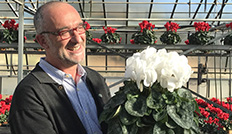 Professional area | Culture factsheet | Feeding | Physiological disorders
Professional area | Culture factsheet | Feeding | Physiological disorders
Here are listed different vegetative abnormalities, which we have named "physiological disorders". They are often caused by climatic stress. This list is not axhaustive.
Flower-edge necrosis corresponds to a physiological disorder which causes spots of dead tissue on the edges of the plant’s organs. These manifestations are essentially related to calcium deficiency in the organ during its development, especially in the phase of cell elongation. It should be noted that, in general, the symptoms can be seen to match on the upper and lower surfaces of the leaf.
These phenomena often occur in the inter-seasonal period. The various mechanisms that can lead to this necrosis are:
High humidity in the glasshouse reduces the plant’s transpiration. Calcium, which is not very mobile by nature, then reaches the young cells only with difficulty.
Calcium is poorly taken up in oxygen-limiting conditions at the root. Calcium is better assimilated if waterings are short and frequent.
It is advisable, then, before each stage where there is a danger of necrosis, to prevent the phenomenon with an irregular watering pattern: an alternation of short and frequent waterings with an occasional long and slightly leaching application.
The higher the salinity, the more the availability of the water is reduced. Transpiratory flow is less, and calcium moves towards the young cells only slowly. The salinity level must be low enough, and as constant as possible.
N/K and K/Ca balances can be maintained, provided that the watering arrangements can be altered.
The malformation of floral peduncles is to be related to two variables:
1 - Improper plant protection treatments,
2 - Irregular climate management, or management of watering and of conductivity.
Peduncle cells are young cells, and highly susceptible to the availability of water, nitrogen, and thus salinity. Their size and turgor will therefore be altered depending on these circumstances. Any irregularity leads to an alternation of long and short cells, which is what causes the malformations.
Lightish patches may appear in the central region of petals – their aspect is easily mistaken for the disease oïdium. This may be caused by molybdenum deficiency.
Molybdenum is particularly involved in all stages of fertilisation and maturing of the reproductive organs. Molybdenum is transferred poorly where pH is low. This relative lowering of pH at the roots may be related to a strong vegetative activity (linked to an excess of nitrogen) or to root death in a mildly asphyxiating environment.
This is a scorching visible at the leaf margins. It is to be traced to excessive radiation in the glasshouse (especially in summer), which leads to excess salinity.
If this symptom appears, keep a close watch on medium conductivity and pH, and water with pure water to regain the correct level of salinity.
The young leaves curl and take on a spoon shape. The cause is induced boron deficiency. Boron is an element which is more poorly transferred within the plant the lower the humidity of the medium, and the higher the temperature.
This phenomenon is very pronounced with mediums that have a coarse porosity. Contact between the root and the medium is poor, and the danger of deficiency is increased.
The phenomenon can be corrected by re-establishing a proper flow of fluids:
2565, rue de Montourey
83600 Fréjus - France
International telephone : +33 (0)4 94 19 73 04
Switchboard : + 33 (0)4 94 19 73 00
Fax : +33 (0)4 94 19 73 19

